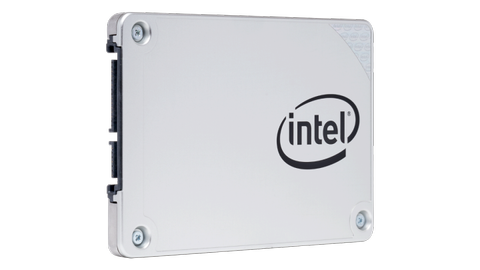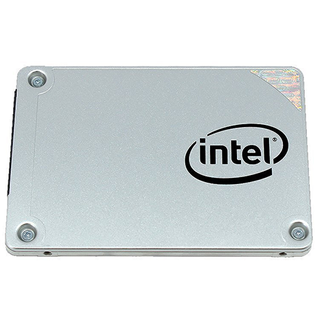Early Verdict
Intel set the bar very low for mainstream SSDs with the SSD 540s, but the market will continue on. This drive delivers less performance per dollar compared to market leaders and fails to compete with offerings from Tier 3 manufacturers. If you want a reliable SSD, this may be the best TLC model outside of Samsung. At the same time, it doesn't give us a reason not to buy a Samsung 850 EVO. We have to wonder what is going on at Intel for the company to delay taking advantage of its new IMFT 3D NAND that is already shipping.
Pros
- +
SSD Optimizer software is very good and includes several nice features
- +
Reliability
- +
5-year warranty
Cons
- -
Expensive
- -
Under performs compared to other mainstream SSD offerings with lower prices
Why you can trust Tom's Hardware
Specifications And Features
Two years ago, we learned that Intel started working with Taiwanese fabless semiconductor manufacturer Silicon Motion, Inc. (SMI). The scrappy SMI enchanted SSD manufacturers in 2014 with its high-performance, low-cost, four-channel flash processors, which helped move us out of the SandForce era. SMI has had several design wins with prominent SSD giants such as Crucial and SanDisk, and the Intel SSD 540s represents another big achievement for the company. The SMI controller powers the Intel 540s up to 78,000/85,000 random read/write IOPS, which is a perfect example of why the controllers have become so popular.
The Intel 540s is our first look at the new SMI SM2258 controller, but this SSD has an interesting backstory, too. Intel paired the controller with SK Hynix 16nm 3-bit-per-cell NAND flash because Intel didn't collaborate with IMFT partner Micron on 16nm flash, instead choosing to focus its resources on the upcoming 3D NAND and Optane (3D XPoint) products. The move left Intel, one of the very few NAND flash manufacturers, as a customer rather than a market leader for an entire generation of products.
Intel is struggling to be competitive in the entry-level and mainstream SSD markets in this new role. The problem for Intel as a flash customer comes down to pricing. Intel gets a price break on flash as a NAND manufacturer, but as a flash customer, Intel is forced to pay a markup on the NAND, which is the most expensive component inside the case. The second issue with being a customer, rather than a builder, is the lack of the intimate NAND knowledge that allows for a faster time-to-market.
Intel's lack of low-cost, in-house flash has left the 3- and 5-Series SSD lines with stale products that struggle to be competitive in pricing and performance. The last 3-Series release dates back to 2012. Intel chose not to participate in the fast-growing consumer SSD segment after it moved the 3-Series SSDs to end-of-life status.
The 5-Series crept on with infrequent updates and continued to use a SandForce SF-2281 flash processor from 2012, that is, until the release of the SSD 540s. Other SSD manufacturers, large and small, have at least two product generations separating SandForce 2281-based models and current-generation SSDs. In some ways, the leap from SSD 535 to 540s shows us that progress doesn't always mean a step forward, as you will see in our tests.
The relaxed release schedule does allow Intel to focus on core product values. Intel likes to tout the low, industry-leading RMA rates for its SSD products. Two years ago, we visited Intel's SSD-validation lab and can summarize the work done there in three words: testing, testing and more testing. As previously mentioned, the Silicon Motion partnership with Intel started at least two years ago. It wouldn't surprise us if the SSD 540s was in testing for most of that time.
Performance aside, the new 540s brings mainstream features with it. Hardware-based 256-bit encryption is standard on this drive. Customers no longer need to look at Intel's Pro Series SSD lineup to get the encryption features required for many industries. The 540s also ships with a five-year warranty, but I wouldn't consider the current warranty process customer-friendly after experiencing firsthand what is involved and how long the RMA processes takes.
Technical Specifications
The Intel SSD 540s ships in six different capacities that range from 120GB to 1TB. All six sizes ship in 2.5 inch and M.2 2280 form factors. Intel has a long history of giving users capacity choices outside of the mainstream, so this series, like many before it, also ships in 180GB and 360GB.
On paper, the performance looks attractive for a modern mainstream product, but Intel generates the performance numbers in a fresh-out-of-box state (per Intel's documentation), and there is no mention of native TLC write speeds. Intel isn't the only company hiding its native TLC write performance, which occurs outside of the SLC cache buffer.
The sequential read performance clocks in at 560 MB/s, which is at the upper limits of SATA 6Gbps (after accounting for overhead). The sequential write performance (within the SLC buffer) ranges from 400 MB/s to 480 MB/s with a progressive uptick as capacity increases. Random performance also scales with capacity. The 480GB drive we have on hand delivers 85,000/78,000 IOPS of random read/write performance.
Intel chose to utilize the SM2258 in tandem with SK Hynix 16nm TLC planar flash for the SSD 540s. Silicon Motion hasn't released many details about the SM2256's successor. After talking with the company, we expected to see the latest four-channel controller appear simultaneously with IMFT 3D flash. It appears Intel has exclusive use of the SM2258, at least for now. Because of that, it's difficult to find additional information about the controller and what features differentiate it from the previous-generation product.
The Intel SSD 540s does support the AES 256-bit full-disk encryption that is compatible with TCG Opal and Microsoft's eDrive. Intel also chose the same controller for the Intel Pro 5400s SSD. The 5400s enables support for vPro technology, which provides advanced management features.
Pricing, Warranty And Accessories
The SSD 540s ships with 12 different product SKUs thanks to the two form factors and six separate capacities. The 480GB model we have sells for $145 at the time of writing. The price is slightly lower than the current mainstream SSD market leader, the Samsung 850 EVO 500GB.
Intel covers the 5-Series with a five-year warranty that matches the warranties found with the 850 EVO and Intel's 7-Series SSDs. After an extensive investigation, we were unable to find any endurance limitations for the SSD 540s aside from the 1.6 million-hour MTBF figure, which means very little to end users.
The SSD 540s works with Intel's SSD Optimizer and data-migration tool. Users will need to download both tools from Intel's website to take advantage of the advanced software features.
A Closer Look


Intel is not sampling the SSD 540s to media, so our drive arrived from a third party and the damage to the package was outside of our control. This drive has the most generic package I've worked with to date. Product information is nonexistent outside of the "Ideal balance between performance and value" statement.
The retail package also lists the core concepts behind the 7 Series and Pro 5 Series. Retail shoppers will see a note about the five-year warranty, and the schematic on the box indicates that a 2.5-inch product is inside.
Speaking of the inside, Intel went very low-key with the extras. Buyers receive the SSD in an anti-static bag. There is also a sliver of paper and some cardboard filler to give the box volume.




The SSD 540s follows the same design scheme as the most recent generations of Intel SSDs. The drive fits into systems that require a 7mm drive height, which is an increasingly common requirement for notebooks and Ultrabooks that lack an M.2 option.





Our 480GB sample features 512GB of raw flash, and Intel allocates a portion of the flash to background activities, such as replacing failed cells and performance-increasing features. Sixteen flash packages populate all four channels of the SMI SM2258 controller, and each NAND package sports two 128Gb SK Hynix 16nm TLC die.
Intel mixed in NAND packages with different densities to reach the two somewhat odd 180GB and 360GB capacities. This practice never gained wide adoption across the SSD industry, but other companies have done it in the past.
MORE: Best SSDs
MORE: How We Test HDDs And SSDs
MORE: All Storage Content
-
joz Was the OCZ Trion 150 and Mushkin Reactor always that good? While they aren't the Evo, they seem to be performing quite well.Reply -
boller Guys, you've misread "native TLC transfer performance" as being 135MB/s. In fact it's even worse - about 125 MB/s (from eyeballing the graph).Reply
135MB/s is average speed which includes SLC bump in it's calculation.
But it does not change the conclusion, of course: this drive is POS. -
anonymousdude Pricing on amazon is high, well at least it is if you live near a microcenter. If you order from microcenter the 480gb is priced at $120, which is $10 more than the trion 150 which $110 at microcenter and is $120 on amazon. I'd say that at it's a fair price considering Intel's reputation for reliability and well Intel's branding. For reference the 850 evo is $158 on amazon and $150 at microcenter. Not saying that it's a good drive, but to an average person price and reliability are going to matter more than the fact that it slightly slower than some other drives.Reply -
dreamer2908 Reply18452087 said:Was the OCZ Trion 150 and Mushkin Reactor always that good? While they aren't the Evo, they seem to be performing quite well.
Well, Mushkin Reactor uses the same controller (SM2246EN) and NAND (Micron 16nm MLC) as Crucial BX100 does.
The discontinued BX100 performed quite well, so the Reactor should also do. -
Zaxx420 "it doesn't give us a reason not to buy a Samsung 850 EVO."Reply
Bet you have a keyboard macro just for that phrase...lol -
Cyberats Wow, Mushkin Reactor is my surprise in this survey, stable on all fronts where even Samsung Evo is wavering and it's a full 512gb of space or is it a typo ?Reply -
littleleo I would have liked to see the SK Hynix model in the mix the price on those is good and the performance according to my customers is also very good. The specs look better then the Samsung's on the read and worse on the write; I just wish they offered a 1TB version.Reply -
mapesdhs C.R., I thought toms was going to stop using graphs with non-zero origins? The sequential read and notebook battery life graphs are visually misleading. There's no point using a graph if its visual appearance does not convey data difference.Reply


